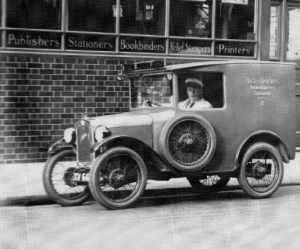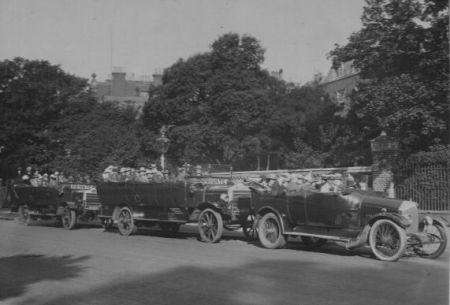The Clapham Society Local History Series — 35
Battley Brothers Printers of Clapham
by Alyson Wilson
This article first appeared in the South London Press on 19 January 2018
(Entitled: ‘Printing Pioneers’)

Battersea c. 1910
In October 1897 17-year old John Battley and his 20-year old brother George set up a printing press in the terraced house they lived in with their parents in Battersea. At the time they were both apprentice compositors at the printing works of the London, Chatham & Dover Railway at Victoria Station. They were frustrated by the monotonous and repetitive work they had to do from 8 am to 6 pm six days a week, with no opportunity for self-expression or ambition. So using the savings they had accumulated by selling tea and refreshments to fellow workers they set up a printing press at home to work on in the evenings while keeping their day jobs to complete their apprenticeships.
By 1904 the brothers were confident enough to leave their day jobs, incorporate the company and take a lease on an existing printing works in Queen’s (now Queenstown) Road. The work was mainly handbills and local posters, though the shop window proudly announced ‘Every description of printing executed…’.

The business developed steadily until the advent of WW1 when many staff volunteered for military service and John Battley, a conscientious objector, was sent to work in a market garden in Twickenam. The company survived the war and expanded rapidly in the 1920s, first taking on adjoining premises and then moving to a new location in Clapham Park Road. By this time Battley Brothers as the company was known, despite the departure of George Battley, also operated a lending library and a stationery shop.

In the 1930s the company gained a reputation not only for high quality printing but also for design, commercial art and photography. John Battley himself moved in to writing and publishing and for several years produced an annual Clapham Guide which combined historical background with information about local organisations and services.
Battley Brothers was a generous employer, organising outings to theatres and exhibitions and the annual seaside outing known in the printing trade as a ‘wayzgoose’. It was also a family firm – a status emphasised when 52-year old John Battley married his 29-year old bindery supervisor.

Although the 1930s were difficult times business increased with diversification into catalogues and exhibitions. But WWII soon provided new challenges. John Battley kept wartime diaries which recorded the number of air raid warnings – 400 in a period of three months in 1940 – and then on 27 September a bomb fell just outside the office putting out light, power and water (gas and telephone has been cut two weeks earlier). In addition there was a shortage of paper and strict control on its use: in 1941 Christmas cards, calendars, programmes and free circulars were banned and theatre and cinema posters were restricted to ten copies.
Meanwhile John Battley had political ambitions, and having been elected to the London County Council in 1938, in 1945 he was elected as the first Labour Member of Parliament for Clapham. However, the huge burden of running the company during the daytime followed by attending the House of Commons every evening often into the early hours of the morning took a toll on his health. After a short illness he died in 1952, at the age of 71 years. His wife, Sybil, immediately took over as managing director, running the business with the assistance of the loyal staff. For ten years she was in charge until her son Bernard, had completed his training at the London College of Printing, and was ready to take over the helm.
The Swinging Sixties were boom years for Battleys. New machines were introduced and high standards of production led to many awards. Most exciting of all was the invitation to print the programmes for the newly opened National Theatre. At that time theatre programmes were little more than cast lists, and it was the theatre’s resident designer at the time, Ken Briggs, who introduced programmes with illustrations, scholarly essays and biographies. It was he too who spotted a Battley’s promotion using exactly the shade of matt black he had in mind. This started a link with the National Theatre which has lasted to this day when the successor company to Battleys still print the National Theatre programmes. It also started the move to specialisation in programmes, so that within a few years Battleys were printing programmes for the English National Opera, Henry Wood Promenade concerts at the Albert Hall, the Festival Ballet, and from its opening, the Globe Theatre.
The firm grew apace under the direction of Bernard Battley, son of founder John Battley, and in 1998 celebrated its centenary. Still at this time effectively a family firm with many long-tem employees, as Bernard approached retirement and no family member was available to take his place a merger was arranged with a larger firm and the printing works moved from Clapham to Battersea. Finally in 2012 all printing moved to Coventry, so that after nearly 115 years the story of Battley Brothers, the Clapham printers drew to a close.
NOTE: All photographs © Bernard Battley.